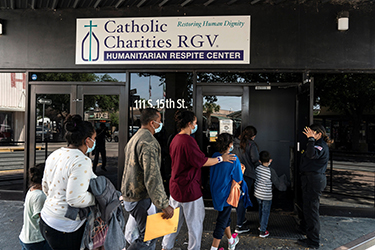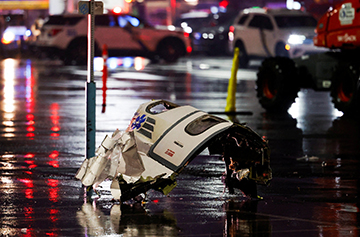
NATION
WASHINGTON (OSV News) – Coinciding with the Catholic Church’s Jubilee Year, the Lunar New Year “can be a time of change and renewal” of faith, two U.S. bishops’ committee chairmen said in a special message to Catholics from Asian cultures who celebrate the Chinese New Year. “May the blessings of Almighty God come upon you, so that your Radiant Faith, which enriches the Church, may bring hope and renewal to our world, our country, the Church, and our families,” said Bishop Robert J. Brennan of Brooklyn, New York, and Bishop Earl K. Fernandes of Columbus, Ohio, in a Jan. 28 message issued with their blessings on behalf of all the bishops. They are the chairmen, respectively, of the U.S. Conference of Catholic Bishops’ Committee on Cultural Diversity in the Church and its Subcommittee on Asian and Pacific Islanders. The Lunar New Year usually starts sometime between late January and mid-February. This year the festivities begin Jan. 29, ushering in the Year of the Snake, symbolizing good luck, rebirth and regeneration. Celebrations can last for 15 days in countries where the Lunar New Year is typically celebrated – China, South Korea, Vietnam and countries with a significant number of people from China.
PHILADELPHIA (OSV News) – Archbishop Nelson J. Pérez of Philadelphia is calling for prayer, saying his “heart sank” after learning of a fatal air crash in that city Jan. 31, just two days after a collision between a commercial jet and an Army helicopter in the nation’s capital killed 67. The archbishop issued a statement a few hours after a medical flight carrying a pediatric patient, her mother and crew crashed minutes after takeoff, killing all six aboard and one person on the ground, while injuring 22 others. The jet plunged into a densely populated, heavily traveled area of northeast Philadelphia. Archbishop Pérez called for all people to “unite in prayer and do what we can in the days ahead to share the compassionate love of Christ with those suffering.” As he surveyed the crash site Feb. 1, retired Philadelphia Police Sergeant Mark Palma, a Catholic who dealt with the aftermath of a fatal 2015 Amtrak crash, echoed the archbishop’s call to pray for first responders given the trauma involved. Father Patrick Welsh, pastor of St. Matthew Parish, a couple blocks from the impact site, said he set up Eucharistic adoration for first responders. While no one in the parish lost their life, he said one school family “completely lost their home to the fire” and another was also badly affected.
VATICAN
VATICAN CITY (CNS) – When a holy day of obligation falls on a Sunday and so is transferred to another day, the Catholic faithful are encouraged to attend Mass, but they are not obliged to do so, the Vatican said. The feast of the Immaculate Conception of Mary Dec. 8 fell on the Second Sunday of Advent in 2024 and so, in most dioceses around the world, the feast was transferred to Monday, Dec. 9. Some bishops in the United States insisted the faithful still had a moral obligation to attend Mass on the feast day while others issued a formal dispensation from the obligation. The Dicastery for Legislative Texts, in a September letter to Bishop Thomas J. Paprocki of Springfield, Illinois, had said, “the feast must be observed as a day of obligation on the day to which it is transferred.” But in a formal note dated Jan. 23, the Dicastery for Divine Worship and the Discipline of the Sacraments said it had consulted with the legislative texts office and determined that “in the event of the occasional transfer of a holy day of obligation, the obligation to attend Mass is not transferred.”
VATICAN CITY (CNS) – A nerdy love of science fiction, a yearning for adventure, a passion for science and a foundation of Jesuit education all helped in some way to lead a man from Detroit, Michigan, to become a master of meteorites and the head of the Vatican Observatory. Jesuit Brother Guy Consolmagno, who has led the observatory since 2015, shares his journey of becoming a Jesuit astronomer, explains the compatibility of science and faith and guides readers on how to look at the heavens in a new book released Feb. 4 by Loyola Press. Titled, “A Jesuit’s Guide to the Stars: Exploring Wonder, Beauty and Science,” the book also features full-page color astrophotographs taken by astronomers of the Vatican Observatory and NASA.
WORLD
SÃO PAULO (OSV News) – Violence in Colombia between the National Liberation Army and a dissident group of the Revolutionary Armed Forces of Colombia, or FARC, known as FARC in Catatumbo region has led to over 80 deaths and displaced 48,000 people since mid-January. The Catholic Church has been actively working to provide relief, calling for respect for humanitarian principles and access to food and water in the region. Father Hector Henao, who has mediated between the government and guerrillas, emphasized that control over Catatumbo’s illicit coca trade and precious metals is fueling the conflict. Many displaced people were small-scale coca farmers, and while some are returning as the violence subsides, tensions remain high. In response, local parishes are distributing food, aiding in the release of captives, and organizing peaceful protests. Father Jairo Gélvez Tarazona highlighted the efforts of the community of Pacelli, which is moving away from coca production in favor of sustainable crops like cocoa and fish farming, though economic support from the government and international groups is still needed. On Jan. 26, he celebrated Mass for the community, who almost entirely turned up to march that day for peace in the region.
GAZA CITY, Gaza Strip (OSV News) – A fragile ceasefire between Israel and Hamas has paused air raids and bombings on Gaza, but the humanitarian crisis continues to worsen. Joseph Hazboun, regional director of the Catholic Near East Welfare Association, describes the situation as bleak, with over 17,000 children orphaned and at least 150,000 pregnant women in urgent need of health care. Mental health issues are widespread, with 1 million children requiring psychological support. CNEWA is providing essential relief, including food, medical care and psychosocial programs. However, the region’s challenges persist, including limited access due to road closures and ongoing reconstruction needs. Hazboun also highlights the diminishing Christian population, now down to about 600, with only 300 expected to remain after the Rafah crossing reopened Feb. 1 – so far for medical assistance border crossing for those wounded. While the ceasefire offers temporary relief, Hazboun and other experts warn that lasting peace remains uncertain, with deep-rooted issues between Israelis and Palestinians unresolved.





